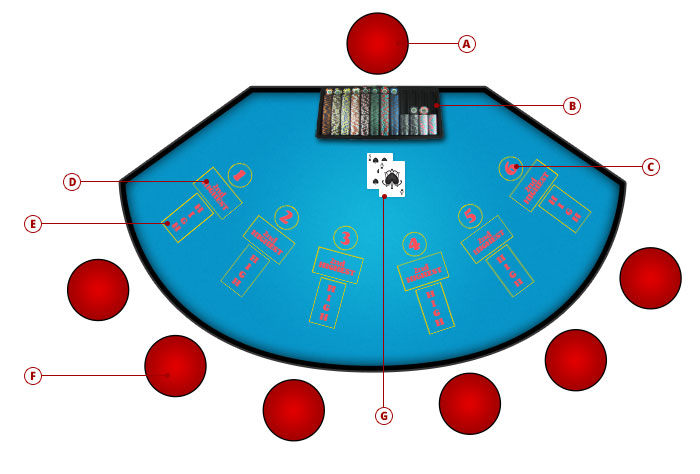How to Play Pai Gow Poker
Pai Gow Poker has its roots in 1980s California, where smaller card clubs were hoping to compete with the bigger casinos in and around Los Angeles and wanted to bring something new to the felt. Developed by Sam Torosian, the game became a smash hit and spread to casinos online and to venues across the globe.

- ADealer
- BHouse Chips
- CBetting Spot
- DLow Hand Box
- EHigh Hand Box
- FPlayer Seat
- GDealer Hand
Rules
Pai Gow Poker uses a 53-card deck - a joker is included that functions as a wild card, used to form an ace or to be used to finish a royal flush, flush, straight or straight flush. Players can either face off against a dealer or against other players; the goal of the game is to have both the high and low hands beat those of the banker, who may be the dealer or another player. In land-based casinos, the role of “banker” might move from player to player after each hand, or the dealer may sub in as the banker if there is only one player present.
The player begins by making an ante wager, after which both they and the banker are each dealt seven cards. They must then create a high hand consisting of five cards and a low hand consisting of two cards.
The best combination for the low hand is a pair. Should the player not hold a pair in the low hand, its value will be established based on each of the cards. High cards are ranked as in traditional poker and must have a greater value than that of the low hand.
After the player has finished, the banker then repeats the process, turning over their cards and forming a high and low hand. If the player can only beat one of the banker’s hands, a push is declared and neither side wins. Should the banker and player have a tie (both possessing cards of the same value), the banker wins.
Payouts vary between sites and venues, but online players can expect to receive a payment at 150:1 for a royal flush, 25:1 for four of a kind and 2:1 for a straight. It’s always a good idea to check the paytables at a casino, whether online or offline, to see what you could win!
The house edge in Pai Gow Poker varies depending on whether or not the dealer is banking or another player has taken on the role. If the dealer is acting as the banker, the house edge is 2.68 percent. However, that drops to 0.20 percent if a player is banking. The general house edge is 1.45 percent, based on the assumption that players and the dealer are taking turns as the banker.
Pai Gow Poker Side Bets
A common Pai Gow Poker side bet called “Fortune” pays out based on the value of the player’s seven cards taken together. A player who has a natural seven-card straight flush (all cards of the same suit in consecutive order) can stand to win quite a hefty payout, should they beat odds of 1 in 4,816,971!
Jokolor is another popular side bet that provides a bonus payment if the player holds a joker and/or cards which are all of the same colour. Other payouts in Jokolor can be made for simply having a joker in your hand or having a hand with cards that are all the same colour.
Etiquette
You should refrain from touching your chips after placing a bet, and be patient with other players who might take more time to make a decision about their hand. When touching your cards to form your high and low hands, be sure not to fold or bend them, and once you have placed them, do not touch them again. Afterwards, don’t grab your chips until the dealer has settled each bet. You should also avoid pulling your bet when another player banks, as it is considered rude.
Strategy
Know your poker hands before you start so that you don’t risk missing a big payout due to inattention or ignorance.
Pairs can be confusing in Pai Gow Poker, as your low hand cannot have a higher value than your high hand. Here is a useful table for what to do with pairs:
| Pairs Dealt | Course of Action |
|---|---|
| 0 | Use the second and third highest cards in your low hand, moving the rest to the high hand |
| 1 | Move to high hand, placing the highest-value cards left over in your low hand |
| 2 | Move to high hand, placing the highest-value cards left over in your low hand |
| 3 | Move highest-value pair to low hand |
While side bets like Fortune can be entertaining and enhance your gaming experience, the house edge is set quite high and you could end up burning through your bankroll fairly fast. Fortune alone has a house edge of 7.77 percent, while Jokolor has a house edge of 3.89 percent. Stick to the main game unless you can place one side bet and walk away whether you win it or lose.
Important Terms:
You can find more commonly used casino terms on the Glossary page.
